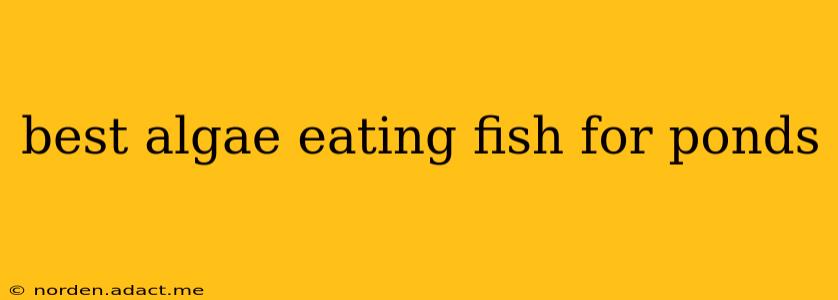Keeping a pond clean and beautiful requires diligent maintenance, and managing algae growth is a significant part of that. While chemical treatments exist, introducing algae-eating fish is a natural and often more effective solution. But with so many species to choose from, selecting the right fish for your pond can be overwhelming. This comprehensive guide explores some of the best algae-eating fish for ponds, helping you make an informed decision based on your pond's size, environment, and your personal preferences.
What are the Best Types of Algae Eating Fish for Ponds?
Several fish species are known for their appetite for algae, contributing to a cleaner and healthier pond ecosystem. The "best" choice depends entirely on your specific situation. Let's explore some popular options:
1. Koi (Cyprinus carpio): The Majestic Algae Eater
Koi are undoubtedly one of the most popular pond fish, prized for their vibrant colors and graceful movements. While not exclusively algae eaters, they consume significant amounts of algae as part of their diet, contributing to pond cleanliness. Their size, however, necessitates a large pond with ample space to thrive.
2. Grass Carp (Ctenopharyngodon idella): The Algae Control Specialists
Grass carp are incredibly efficient algae eaters, capable of significantly reducing algae populations in ponds. However, their voracious appetites and rapid growth necessitate careful consideration. They can potentially overconsume aquatic plants if not managed correctly, disrupting the pond's ecosystem balance. In many regions, introducing grass carp requires permits due to their potential impact on native ecosystems. Always check your local regulations before introducing grass carp to your pond.
3. Common Pleco (Hypostomus plecostomus): The Bottom-Dwelling Algae Cleaner
Common plecos are known for their ability to clean algae from pond surfaces, particularly submerged rocks and decorations. However, they are not as efficient as grass carp in controlling free-floating algae. Keep in mind that plecos grow quite large and require a spacious pond. They also need specific water conditions to thrive.
4. Sterbai Corydoras (Corydoras sterbai): The Tiny but Mighty Algae Muncher
Sterbai Corydoras are smaller catfish that are less impactful on the larger pond environment, while still offering good algae control. They primarily feed on algae that settles on the bottom, making them a good complement to other algae-eating fish. They're also less demanding in terms of pond size and water conditions compared to larger species.
5. Goldfish (Carassius auratus): A Versatile and Popular Choice
While not as efficient as dedicated algae eaters like grass carp, goldfish can help control algae growth, especially if you have a smaller pond. They are relatively low-maintenance and come in a variety of colors and breeds, adding visual appeal to your pond.
How Many Algae-Eating Fish Do I Need?
The number of fish you need depends heavily on the size of your pond and the level of algae growth you want to control. There's no one-size-fits-all answer. As a general rule, start with a smaller number and monitor the algae levels. If necessary, you can always add more fish later. Consult with a local pond specialist or aquatic expert for personalized advice tailored to your specific pond and its algae problem.
What Other Factors Should I Consider?
Choosing the right algae-eating fish involves several other considerations:
Water Quality:
Ensure your pond has consistently good water quality. Regular testing and appropriate filtration are crucial for the health of your fish and the overall pond ecosystem.
Pond Size:
Select fish species appropriate for your pond's size. Larger species like koi and grass carp need considerable space, while smaller fish are suitable for smaller ponds.
Plant Life:
Consider the impact of your chosen fish on existing plant life. Some fish, particularly grass carp, can consume aquatic plants, so select fish wisely if you want to maintain a balanced aquatic plant ecosystem.
Local Regulations:
Before introducing any fish to your pond, familiarize yourself with local regulations, as some species require permits or are prohibited.
What if Algae Control Doesn't Improve After Introducing Algae Eating Fish?
If you've introduced algae-eating fish and still struggle with excessive algae growth, consider these factors:
- Overfeeding: Excess fish food can contribute to algae blooms. Feed only what your fish can consume within a few minutes.
- Nutrient levels: High nutrient levels in the pond water can fuel algae growth. Test your water regularly and consider adding water plants to help absorb excess nutrients.
- Sunlight exposure: Reduce sunlight exposure to the pond, especially during peak hours, if feasible, to lessen algae growth. Floating plants can also help here.
- Water circulation: Adequate water circulation prevents stagnation and helps to control algae.
By carefully considering these factors and selecting the appropriate species for your pond, you can effectively manage algae growth using algae-eating fish, creating a cleaner, healthier, and more beautiful aquatic environment. Remember always to prioritize the well-being of your fish and the delicate balance of your pond ecosystem.
